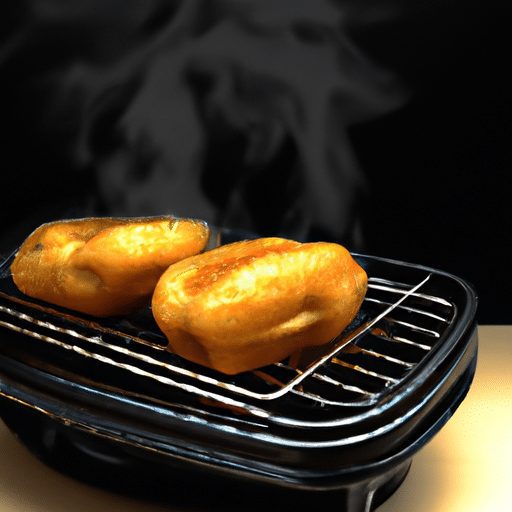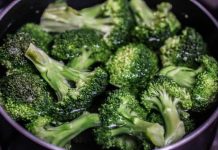Let’s talk about the hidden downside of the beloved air fryer. While it has become a superstar in the kitchen, promising crisp and golden goodies with minimal oil, there is a lesser-known concern that we need to address. It’s time to shed some light on a potential downside, a side effect that might not be so favorable. Join us as we explore the negative side effect of air fryers and uncover the truth that lies beneath their seemingly flawless cooking capabilities.
Health Risks
Formation of Acrylamide
The formation of acrylamide is a potential health risk associated with air fryers. Acrylamide is a chemical compound that forms when starchy foods, such as potatoes and bread, are cooked at high temperatures. This compound is classified as a probable human carcinogen by the International Agency for Research on Cancer (IARC). Regular consumption of foods containing acrylamide may increase the risk of developing certain types of cancer.
Increased Risk of Cardiovascular Diseases
Another health concern related to air fryers is the increased risk of cardiovascular diseases. The high-heat cooking method used in air fryers can lead to the formation of harmful compounds, such as advanced glycation end products (AGEs) and heterocyclic amines (HCAs). These compounds have been linked to inflammation, oxidative stress, and an increased risk of heart diseases.
Risk of Obesity
While air fryers are often promoted as a healthier alternative to deep frying, they can still contribute to weight gain and obesity if not used properly. The crispy texture and delicious taste of air-fried foods may tempt individuals to consume larger portions or indulge in unhealthy food choices more frequently. Overconsumption of fried foods, even when prepared in an air fryer, can lead to weight gain and various associated health risks.
Loss of Nutrients in Food
Air frying can cause a loss of nutrients in food due to the high heat and prolonged cooking times. Some vitamins, such as vitamin C and B vitamins, are heat-sensitive and can be significantly reduced during the air frying process. Additionally, the loss of moisture during cooking can further contribute to the degradation of certain nutrients. While air-frying may be a convenient cooking method, it is important to consider the impact on the nutritional value of the food being prepared.
Issues with Non-Stick Coating
Many air fryer baskets and trays come with non-stick coatings to prevent food from sticking and facilitate easy cleaning. However, the non-stick coating used in some air fryers can release harmful chemicals when exposed to high temperatures. These chemicals, such as perfluorooctanoic acid (PFOA), have been linked to various health issues, including hormone disruption and certain types of cancer. It is essential to choose air fryers with non-stick coatings that are free from these potentially harmful substances.
Potential Harmful Chemicals
Presence of Polycyclic Aromatic Hydrocarbons (PAHs)
Air fryers can generate polycyclic aromatic hydrocarbons (PAHs) when fats and oils are heated at high temperatures. PAHs are a group of chemicals that can form during the cooking process and can be found in the smoke and char on grilled and fried foods. Some PAHs are considered harmful and have been associated with an increased risk of cancer.
Formation of Toxic Fumes
When cooking certain foods in an air fryer, the high heat can produce toxic fumes, such as acrolein and acrylonitrile. These fumes can be harmful if inhaled in large quantities or over a prolonged period. It is important to ensure proper ventilation when using an air fryer to minimize exposure to these toxic substances.
Release of Perfluorooctanoic Acid (PFOA)
As mentioned earlier, some air fryers use non-stick coatings that contain perfluorooctanoic acid (PFOA). When these coatings are exposed to high temperatures, PFOA can be released into the air, especially if the coating is scratched or damaged. PFOA is a potentially harmful chemical that has been associated with adverse health effects, including liver damage, immune system disorders, and developmental problems in children.
Food Quality and Taste
Food Texture Changes
The cooking method used in air fryers can result in changes in food texture. While some people enjoy the crispy exterior of air-fried foods, others may find it less appealing or miss the soft and tender texture achieved through other cooking methods. Additionally, certain foods may become too dry or chewy when prepared in an air fryer, leading to a less enjoyable eating experience.
Loss of Moisture
Air frying requires hot air circulation to cook food, which can result in the loss of moisture. This can be particularly problematic when cooking lean meats or delicate foods that are prone to drying out. The moisture loss can impact the overall juiciness and tenderness of the food and may require additional preparation techniques, such as marinating or basting, to help retain moisture.
Lack of Crispy Coating in Some Foods
While air fryers are known for their ability to produce crispy foods, not all dishes achieve the desired level of crunchiness. Foods with a high water content or a wet batter, such as certain vegetables or battered seafood, may not develop a crispy coating when air-fried. This can be disappointing for individuals who enjoy the satisfying texture of deep-fried foods.
Potential for Overcooking or Burning
Air fryers cook food quickly, and it is easy to accidentally overcook or burn the food if proper attention is not given. The recommended cooking times and temperatures may vary depending on the specific model and the type of food being prepared. Care must be taken to avoid leaving food in the air fryer for too long, as it can result in a dry, charred, or unappetizing outcome.
Energy Consumption
High Power Usage
Air fryers require a significant amount of electricity to generate the hot air needed for cooking. The high power usage can contribute to increased energy consumption in the household. Individuals concerned about their carbon footprint or looking to reduce energy costs may find this aspect less favorable compared to other cooking appliances that consume less energy.
Potential Increase in Electricity Bills
The frequent use of an air fryer can potentially lead to higher electricity bills. As mentioned earlier, air fryers consume a significant amount of power, and if used regularly, the energy consumption can accumulate over time. It is important to consider the potential impact on household expenses and energy usage when incorporating the use of an air fryer into the cooking routine.
Limited Cooking Capacity
Restriction on the Quantity of Food
Air fryers typically have limited cooking capacities due to their compact size and design. Large batches of food may need to be cooked in multiple rounds, which can be time-consuming and inconvenient. This limitation may pose challenges when cooking for a larger group or when preparing meals that require cooking various components simultaneously.
Size Limitations for Certain Dishes
Some dishes, such as whole chickens or larger cuts of meat, may not fit comfortably in the cooking basket or tray of an air fryer. The size limitations of the appliance can restrict the types of recipes that can be prepared effectively. Individuals who frequently cook meals that require larger cooking vessels may find the size limitations of air fryers to be a disadvantage.
Environmental Impact
Generation of Carbon Footprint
The energy consumption and frequent use of air fryers contribute to the generation of a carbon footprint. The electricity used to power the appliance often comes from non-renewable sources, leading to increased greenhouse gas emissions. Individuals concerned about their environmental impact should consider the energy efficiency and sustainability of air fryers when making purchasing decisions.
Potentially Non-Recyclable Parts
Some components of air fryers, such as the non-stick coating or certain electronic parts, may not be easily recyclable. The complex construction and combination of materials in air fryers can present challenges for proper disposal or recycling at the end of their lifespan. It is essential to research the materials and recycling options available for specific air fryer models to minimize environmental impact.
Cost Considerations
Initial Cost of the Air Fryer
Air fryers can vary significantly in price, ranging from affordable options to more expensive models with additional features. The initial cost of purchasing an air fryer may be a deterrent for individuals on a tight budget or those who do not anticipate using the appliance frequently. It is essential to consider the long-term value and frequency of use when evaluating the cost-effectiveness of an air fryer.
Cost of Replacement Parts or Accessories
Over time, certain parts or accessories of an air fryer may need to be replaced, such as the cooking basket, non-stick coating, or filters. The cost of these replacement parts can add up and should be taken into account when considering the overall expenses associated with owning an air fryer. Regular maintenance and replacement of worn-out components will contribute to the longevity and effectiveness of the appliance.
Maintenance and Cleaning Expenses
Air fryers require regular cleaning and maintenance to ensure optimal performance and food safety. Cleaning the cooking basket, trays, and other components can require extra time and effort. Additionally, certain models may require periodic oiling or degreasing to maintain the appliance’s functionality and prevent the build-up of residue. The cost of cleaning supplies and any specialized cleaning products should be considered as part of the overall expenses.
Noise Levels
Loud Operation Sound
Air fryers can produce loud operation sounds during the cooking process. The whirring of the fan and the circulating air can be disruptive in quiet environments or open-concept kitchen layouts. Individuals sensitive to noise or those seeking a quieter cooking experience may find the persistent noise generated by air fryers to be bothersome.
Risk of Fire or Accidents
Potential for Overheating and Fire
Like any electrical cooking appliance, air fryers come with a risk of overheating and potentially causing a fire. Factors such as improper use, mechanical malfunctions, or ignoring safety precautions can increase the likelihood of accidents. It is crucial to follow the manufacturer’s instructions, use the appliance on suitable surfaces, and never leave the air fryer unattended during operation to minimize the risk of fire.
Risk of Burns or Injuries
Air fryers can reach high temperatures, and accidental contact with hot surfaces or hot oil can result in burns or injuries. Care must be taken when handling the cooking basket, trays, and other components immediately after cooking to avoid accidental burns. It is also important to avoid overcrowding the air fryer, as it can increase the likelihood of splattering and potential injuries from hot oil or food particles.
Potential for Misuse or Overreliance
Neglecting Other Cooking Methods
The convenience and speed of air frying may lead some individuals to rely solely on this cooking method and neglect other cooking techniques. While air frying can be a healthy alternative to deep frying, it is important to maintain a varied diet and utilize other cooking methods, such as steaming, boiling, or grilling, to ensure a balanced and nutritious meal plan.
Inadequate Cooking Times or Temperatures
Proper cooking times and temperatures are crucial to ensure the safe and effective preparation of food. Inadequate cooking times or temperatures in air fryers can result in undercooked food, compromising food safety and increasing the risk of foodborne illnesses. It is essential to follow recipe guidelines and use the appropriate settings to guarantee that food is cooked thoroughly and safe for consumption.
In conclusion, while air fryers offer a convenient and healthier alternative to traditional deep frying methods, there are several negative side effects and considerations that individuals should be aware of. Health risks, potential exposure to harmful chemicals, changes in food quality and taste, energy consumption, limited cooking capacity, environmental impact, cost considerations, noise levels, risk of fire or accidents, and the potential for misuse or overreliance are among the key areas of concern. It is important to carefully evaluate these factors and make informed decisions regarding the use and incorporation of air fryers into one’s cooking routine. By weighing the potential advantages and disadvantages, individuals can determine whether an air fryer is the right fit for their lifestyle and cooking needs.





































